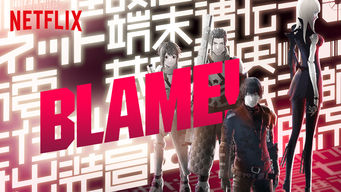This review is based only on the animated film adaptation.

Fight for human life in Blame!
After nearly ten years of planning, the CG animated film adaptation of Tsutomu Nihei’s 1998 manga Blame! hit screens globally on May 20 as a Netflix original. Blame! tells the story of humanity in a cybernetic dystopian wasteland called “The City” as they fight for their lives against robot exterminators called Safeguards. In the distant past, humans once dominated machines by using Net Terminal Genes to control the computerized network of “The City.” However, a contagion eliminated human dominance, reducing life in “The City” to a man-versus-machine battle for survival.
Story:
Blame! follows a group of human villagers scraping together a life in “The City” and their encounter with Killy, an enigmatic traveler in search for the long-lost Net Terminal Genes. Killy is the film’s protagonist, yet other characters such as Zuru, a young and tenacious villager, tend to overshadow him. The action-driven fight scenes eclipse a plot dragged down by film specific words like “Authority” and “NetSphere” that characters throw around without much explanation. Therefore, the audience can feel lost at times as they piece together abstract ideas amidst the action.
Animation:
With clear and crisp CG animation, Polygon Pictures pulls all the stops for Blame!. Well-designed backdrops and machinery make up the background while highlighted armor and detailed hair and facial details pop in the foreground. Animators use a generous amount of warm colors, particularly with on-screen calculations and weaponry, to contrast with the monochrome architecture. What the film lacks in story traction, it makes ups for in eye-candy. Animators construct flawless fight scenes, timing CGI effects of sparks and smoke well without marring the action. The robot and humans’ faces are well rendered and show thoughtful consideration for the characters’ sleek and functional designs. Outside of fight scenes, the CGI effects occasionally muddle the screen. But, for the most part, it enhances rather than detracts.
Sound:
Grand orchestral pieces featuring a female vocalist along with mood making instrumentals characterizes Blame!’s soundtrack. The music tends to borrow from various music genres and creates a dynamic atmosphere throughout the film. The orchestral music conveys a foreboding feeling through sounds harkening to other works like Attack on Titan or Transformers. However, despite the skillful execution of music to heighten tension, the ending electronic pop song “Calling you” by angela breaks the mood. Though the ending fits with the cyberpunk aesthetic, it’s not the ideal to end a dramatic film like Blame!.
Characters:
As mentioned earlier, Killy, the would-be protagonist, ultimately becoming a side character. This upstaging is, in part, due to his lack of complexity. He lacks urgency and purpose, making him only a handsome vessel of mystery. Other human characters are no better and are too generic to be relatable. They become painful to watch at times as they flash their insecurities as victim cards (looking at you Fusata and Tae) and detract from the film’s visuals.
Despite this, Sutezo and Cib stand out among the other poorly developed characters. Sutezo, the second-in-command villager, acts as a voice of rational and reason despite his minimal screen time. Voice actor Miyano Mamoru makes Sutezo’s character his own in the film, upstaging other characters like Zulu. Cibo, however, guides the viewer into this complex world through her physical development during the movie. Her existence balances off Killy’s lack of explanation for his actions and adds necessary information for the audience to understand the film’s universe.
Final Thoughts:
Even with less than impressive character development and confusing terminology, the eye-catching animation and fast-paced action elevate Blame! to a film that can appreciate by any viewer. However, more than anything, Blame! makes a convincing statement for viewers to explore the manga series and find their answers the film fails to discuss.
Story: 7/10
Animation: 9/10
Sound: 8/10
Characters: 6 /10
Final Grade: 7.5 / 10